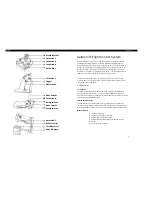
Installation
11
© 2012 DynaGen Technologies Inc.
TOUGH Series User Manual
2.4
Magnetic Pickup / J1939 Interface Harness
The Magnetic Pickup / J1939 Interface Harness is only required if you are using an electronic engine or
acquiring your speed signal from a magnetic pickup sensor.
TERMINAL
FUNCTION
DESCRIPTION
J6-4
CAN Bus High
CAN Bus (J1939) is used for electronic engines that have
an ECM.
J6-5
CAN Bus Low
J6-6
CAN Bus Shield
J6-7
Speed Input A
The speed sensing terminals are not sensitive to polarity.
Magnetic pickups, tachometers, or a flywheel alternator can
be used to provide signal. These inputs are not required if
AC voltage is being used. See
for more information.
J6-8
Speed Input B
NOTE
: Terminals J6-1, J6-2, J6-3, J6-9 and J6-10 are unused. These are left open for future
expansion.
Looking at rear of controller
CAN Bus (J1939) Wiring Considerations
CAN Bus (J1939) is for use with electronic engines. There are some special precautions that need to be
taken when wiring to the electronic control module (ECM).
If controller is not the last device on the bus, connect to the existing bus and ensure that there are
120Ω terminating resistors at each end of the bus.
If controller is the last device on the bus, you must install a 120Ω terminating resistor across the
CAN High and CAN Low lines as shown in the figure below.
If running the cable over a long distance, use Beldan 7895A cable or equivalent cable.
For the ECM to function, it must first receive power for a short time before cranking to allow it to boot. It
is common practice to use the fuel relay to turn the ECM on and off. There are two ways to configure
this:
The fuel relay is on during 'Preheat'. Increasing the 'Preheat' time in the
menu
will allow longer time for the ECM to power up before cranking.
Turning on the 'Auto Power ECM' setting in the J1939 menu enables the fuel relay to be on when
controller is in Auto mode. This way the ECM will be always be on except wen in OFF mode.
37
23












































